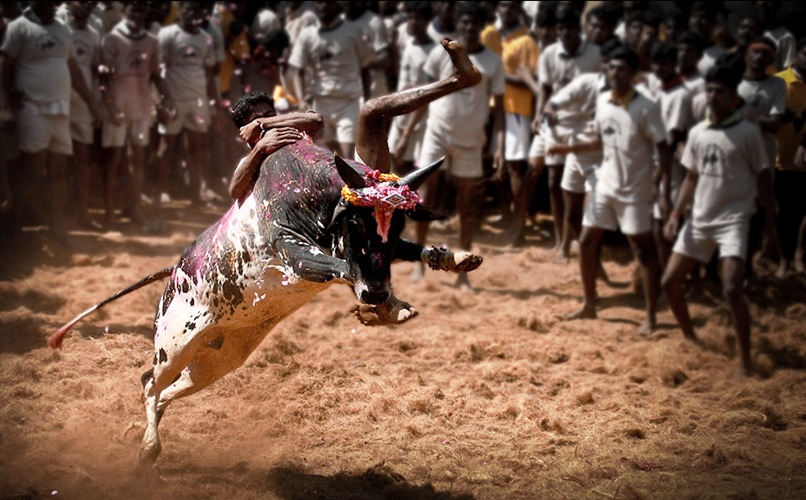Bull Leaping: Traditional and Extreme Sport in Some Cultures

Imagine witnessing athletes perform breathtaking acrobatics over charging bulls, a practice rooted in ancient Minoan civilization. This tradition, known as bull-leaping, still thrives in modern cultures such as Tamil Nadu's Jallikattu. The activity isn't merely a spectacle; it intertwines heritage with extreme sport, demanding skill and bravery.
But what drives individuals to embrace such risks, and how do these events reflect deeper cultural values? As we ponder the delicate balance between tradition and modernity, questions of ethics and significance inevitably arise.
Key Takeaways
- Bull-leaping originated from the ancient Minoan civilization on Bronze Age Crete, showcasing athletic prowess and cultural rituals.
- In Tamil Nadu, Jallikattu is a traditional sport held during Pongal, symbolizing bravery and the bond between humans and animals.
- Minoan bull-leaping involved acrobatic maneuvers, such as somersaults and flips over bulls, requiring exceptional agility and precision.
- Modern events like Course Landaise in France adapt bull-leaping traditions with cows, preserving cultural heritage.
- In Minoan society, bull-leaping had significant religious meaning and may have served as initiation or coming-of-age rites.
Historical Origins
Bull-leaping dates back to the ancient Minoan civilization on Bronze Age Crete, where it served as a ceremonial and religious activity. Minoans held bull-leaping in high regard, integrating it deeply into their rituals. Unlike modern sports, it wasn't merely about entertainment; it was a profound expression of human control over nature.
In the heart of ancient Crete, bull-leaping scenes adorned the walls of palaces and other significant structures, underscoring its importance. These depictions show daring participants vaulting over bulls, a sign of their agility and bravery. It wasn't just a physical feat; it was a symbolic act with deep religious significance.
Interestingly, bull-leaping wasn't confined to Crete. Evidence suggests that bull-leaping scenes appeared in places like Pylos and Tiryns on the Greek mainland, and even in distant lands like the Indus Valley. Scholars have also found similarities in Avaris frescoes and Cappadocia clay envelopes, hinting that this practice might've even older origins.
Cultural Significance
The cultural significance of bull-leaping in Minoan society extended far beyond entertainment, reflecting core values and social structures. Bulls symbolized strength and vitality within this ancient civilization. Bull-leaping ceremonies had a ritualistic purpose, possibly linked to initiation or coming-of-age rites for the aristocracy, reinforcing social hierarchies and the elite status of participants.
Minoan art frequently depicted these events, showcasing the elegance and danger of the sport. Elite art at Knossos often featured bull-leaping scenes, highlighting the intelligence and control the elite class exercised over these powerful creatures. These depictions weren't merely decorative but served as symbols of power and prestige within the Minoan social framework.
Female performers played a prominent role in these rituals, a progressive aspect for the time. Trained female athletes, identifiable by their distinct headgear and costumes, actively participated in bull-leaping, emphasizing the importance of gender roles. Their high social status was evident through their involvement in these esteemed ceremonies, underlining the inclusive yet hierarchical nature of Minoan society. Thus, bull-leaping wasn't just a sport but a profound expression of cultural identity and social order.
Minoan Crete Practices
In Minoan Crete, athletes showcased their skill and agility in bull-leaping, a ritual vividly depicted in frescoes and sealings. During the Bronze Age, this exhilarating practice involved acrobats vaulting over bulls and performing daring stunts that demonstrated their prowess. These scenes, frequently found in Minoan art, highlight the ritual's importance in their society.

Bull-leaping was not just a physical challenge; it carried significant religious meaning. The ritual possibly served as an initiation or coming-of-age ceremony for young aristocrats, symbolizing control and power. Female performers, who held high social positions, actively participated in these events, wearing distinctive headgear and elaborate costumes to distinguish themselves during the ceremonies.
Here is a table summarizing key aspects of Minoan bull-leaping:
| Aspect | Description | Significance |
|---|---|---|
| Ritualistic Practice | Acrobats interact with bulls in specific postures | Demonstrates skill and agility |
| Artistic Depictions | Frequently found in frescoes and sealings | Vivid historical records |
| Female Performers | Active participants with unique attire | High social status |
| Religious Significance | Possibly an initiation or coming-of-age ceremony | Symbolizes control and power |
| Bronze Age Context | Part of Minoan civilization during the Bronze Age | Cultural and historical relevance |
This concise overview ensures semantic accuracy, completeness, consistency, conciseness, relevance, interoperability, and trustworthiness.
Jallikattu in Tamil Nadu

Iamkarna', Madurai-alanganallur-jallikattu, CC BY 3.0
Jallikattu in Tamil Nadu is a traditional sport with deep cultural significance. It isn't merely about the thrill but also about honoring age-old traditions while prioritizing safety. Despite its intensity, measures are in place to protect both participants and bulls, ensuring a balance between cultural heritage and contemporary concerns.
Cultural Significance
Celebrated during the Pongal festival, Jallikattu is a testament to Tamil Nadu's rich cultural heritage and the deep-rooted bond between humans and animals. As you witness the bull-leaping scenes, the cultural significance of this traditional sport becomes palpably clear.
Jallikattu isn't merely an event; it symbolizes bravery, strength, and cultural identity for the people of Tamil Nadu. Originating as a wedding custom among the cowherd community, this traditional sport has endured through time, representing the persistence of long-standing practices.
For the people of Tamil Nadu, Jallikattu is more than a sport; it's a celebration of their history and traditions. Despite ongoing debates about animal welfare, the cultural significance of Jallikattu continues to resonate deeply within the local community. It embodies their heritage, emphasizing the enduring bond between humans and animals, a connection that's central to their way of life and identity.
Safety Measures
Strict safety measures are implemented to safeguard both participants and animals during Jallikattu events in Tamil Nadu. As a traditional bull-taming sport involving intense physical activity, it is crucial to ensure safety for all involved. The arena is surrounded by safety barricades, and medical teams are on standby to provide immediate assistance in case of injuries.
Participants undergo rigorous training to minimize risks and effectively handle the fast-paced nature of Jallikattu. Veterinary experts are also present to monitor the health and well-being of the bulls, conducting regular inspections to ensure they are in good condition.
Key safety protocols include:
| Safety Measure | Purpose |
|---|---|
| Safety Barricades | Protect spectators and participants |
| Medical Teams | Provide immediate medical attention |
| Veterinary Experts | Monitor and ensure animal health and well-being |
These measures are essential for conducting the sport as safely as possible. Adhering to these protocols helps prevent accidents and ensures the welfare of both participants and animals. By maintaining strict safety guidelines, Jallikattu events can continue to be a vital part of Tamil Nadu's cultural heritage while prioritizing safety.
Techniques and Skills
Bull-leaping techniques require athletes to master acrobatic maneuvers such as somersaulting over the bull's horns and executing mid-air flips over its back. These techniques demand agility, coordination, and incredible courage from the performers. Imagine grabbing the bull's horns and somersaulting backward or diving elegantly over its head. Each leap reflects a deep understanding of the mechanics involved. The Taureador Fresco at Knossos visually captures these mechanics, showing acrobats in mid-air and illustrating the intricate skills required.
Studying these techniques reveals that they're as much about timing and precision as they're about physical prowess. Performers must gauge the bull's movements and react swiftly, ensuring their safety while maintaining the fluidity of their acrobatics. This level of skill comes not only from physical training but also from an understanding of the bull's behavior, making it a truly cultural practice.
The cultural significance of bull-leaping extends beyond the sport itself, showcasing the gender dynamics and ceremonial roles within Minoan society. Various theories on the approach to bull-leaping highlight the complexity and finesse needed, underscoring the athletes' dedication and the sport's rich heritage.
Controversies and Debates
Many scholars debate whether Minoan bull-leaping was primarily a ceremonial ritual or a demonstration of physical prowess and dominance. The vibrant frescoes and artworks suggest a blend of both interpretations. Was it a sacred act, or simply a display of skill and courage? The debate continues as the safety and realism of these ancient depictions are scrutinized. Could humans realistically perform such daring feats without severe injury?
The cultural significance of bull-leaping varies across societies. For the Minoans, it might've symbolized a connection to deities, while others see it as a rite of passage or a test of bravery. This duality further fuels controversies, especially when considering its classification as an extreme sport. The inherent danger of interacting with powerful bulls places participants at high risk, raising questions about the ethics involved.
Are the ethical implications justifiable in preserving tradition, or do they overshadow the cultural value? These ongoing discussions challenge us to assess the importance of heritage against potential harm. The complexities of bull-leaping extend far beyond the athleticism it showcases.
Modern-Day Events
Modern-day bull-leaping events such as Jallikattu in Tamil Nadu, India, and course landaise in southwestern France, underscore the sport's enduring cultural significance. Jallikattu, held during the Pongal festival, involves participants trying to tame bulls, demonstrating their bravery and skill. This event is deeply embedded in Tamil Nadu's cultural heritage, highlighting the close relationship between humans and animals in the region.
In southwestern France, course landaise features cows instead of bulls. Participants engage in acrobatic leaps and dodges, maintaining the traditional aspects of bull-leaping while adapting to local customs. Both events illustrate the lasting cultural importance and heritage of bull-leaping traditions.
Frequently Asked Questions
Which Culture Is Associated With the Sport of Bull-Leaping?
Bull-leaping is associated with the Minoan culture of Bronze Age Crete. This ancient civilization depicted acrobats vaulting over bulls in their art, highlighting the sport's ritualistic and symbolic significance in their society.
What Culture Is the Bull Leaping Fresco From?
The bull-leaping fresco originates from the Minoan culture of Bronze Age Crete. Its reconstructed version can be viewed at the Archaeological Museum of Heraklion. The fresco highlights the Minoans' artistic, religious, and ceremonial practices involving bulls.
Where Is the Sport Bull-Leaping Originated?
Bull-leaping originated in the Minoan civilization on Bronze Age Crete. It later spread to regions such as Egypt and Syria, reflecting a shared cultural heritage and historical significance across these ancient civilizations.
What Was Bull-Leaping in Ancient Greece?
Bull-leaping in ancient Greece, particularly among the Minoans, was a ceremonial and religious activity depicted in Minoan art. This ritual involved acrobats, both male and female, vaulting over bulls. It possibly served as an initiation rite, symbolizing human mastery over nature.
Conclusion
Bull-leaping seamlessly connects history and the present, blending tradition with athleticism. From ancient Minoan Crete to modern-day Jallikattu in Tamil Nadu, this practice has deep cultural roots. Despite controversies, the skill and bravery required continue to captivate audiences. When you witness a bull-leaping event, you'll appreciate not just the spectacle but the rich heritage and sheer courage behind every leap.




